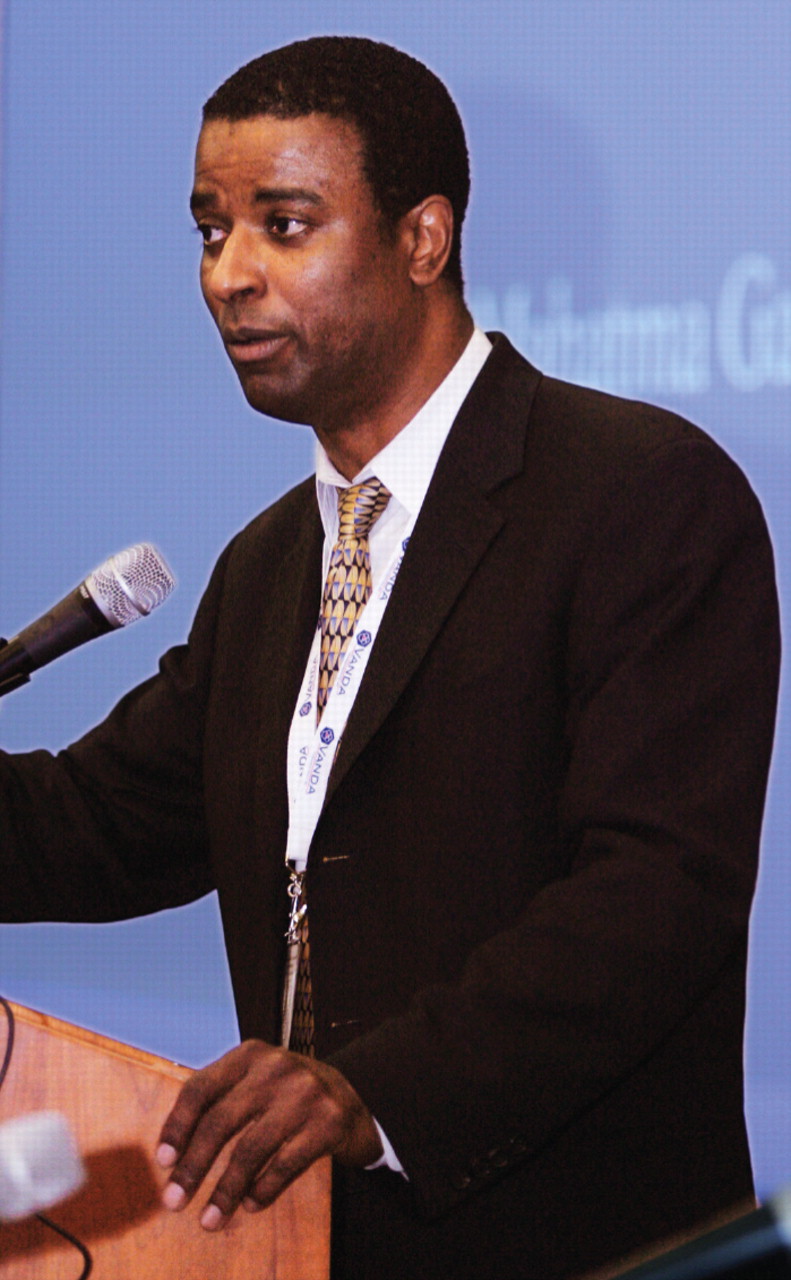The path to treating patients in Boston has led David Henderson, M.D., far afield.
Two years after completing his residency in 1992, it dawned on Henderson that he was struggling to treat a group of patients from a broad spectrum of racial, ethnic, and cultural backgrounds. He realized that the American psychiatric model had its limitations when he prepared to treat patients who were not white or male.
“I realized I had been trained to treat about 1 percent of the world's population,” he told an audience at APA's annual meeting in San Diego in accepting the 2007 Solomon Carter Fuller Award, given each year in memory of the first black psychiatrist in the United States. The award honors an African-American citizen “who has pioneered in an area that has significantly benefited the quality of life for black people.”
Henderson is associate professor of psychiatry at Harvard Medical School and director of the Schizophrenia, Diabetes, and Weight Reduction Research Program at Massachusetts General Hospital. He also studies the impact of trauma in areas of mass violence and develops programs to assist vulnerable populations, including projects in Rwanda, Cambodia, East Timor, Bosnia, New York City, and Louisiana.
Henderson's mentor at Harvard, Chester Pierce, M.D., told him he needed an international experience. Henderson found that experience—and began to understand his dilemma and its solution—in Africa.
In January 1995, he stepped off the plane at a bullet-pocked airport in Rwanda shortly after the genocide that devastated the country. He asked himself: “Did I really need to come here to treat a diverse, international population in the United States?”
The answer, he soon learned, was “yes.”
People of non-European ancestry now make up 35 percent of the U.S. population, and that figure is predicted to increase to 45 percent by 2025. Race and ethnicity affect how these minorities are diagnosed and treated, he said. They are, for example, more likely than white people to be diagnosed with schizophrenia than affective disorders. African Americans often are prescribed higher doses and are more likely to be secured or restrained when hospitalized. Physicians must recognize these patterns, which stem from lack of knowledge or from individual and institutional biases, he said.
“So you have to start addressing this population,” he said.“ They will be your patients, and you have to understand what their lives are like.”
Next, he went to Cambodia. Henderson had treated Cambodians in Boston but couldn't grasp what they had gone through until he visited the country in June 1995.
Psychiatry didn't exist in Cambodia, he said. His job was to train primary care physicians.
His first shock came when he went from having access to a hundred drugs to having just five available. “This was a humbling experience for a psychopharmacologist,” he said.
Talking to patients provided another lesson in cultural anthropology. As part of a routine psychiatric workup, he might ask patients if they heard voices when nobody was in the room. They invariably said, “yes.” Still guided by his American training, Henderson concluded this was a symptom of psychosis.
Puzzled by the consistent responses, he posed the question to the Cambodian doctors he worked with. They, too, said, they heard voices. Finally he asked the minister of health if he heard voices when he was alone. The minister also replied affirmatively.
“I decided then that everybody in Cambodia was psychotic,” Henderson said, recalling how his cultural blinders affected his thinking.
The minister of health finally took pity on the poor foreigner.
“Let's take a minute to help Dr. David, because he is not in touch with his ancestors,” said the minister.
“That opened my eyes in a humbling kind of way,” said Henderson.
Culture isn't just some nebulous background from which patients emerge when it's time to visit the doctor, he found. Culture affects patients' willingness to seek treatment, how they manifest and communicate symptoms, how they cope with illness, and what range of family and community support they receive.
Getting a positive response to, “Do you walk down the street and feel people are out to get you?” may not indicate paranoia to someone who lives in a poor, violent neighborhood.
Genetics Can't Be Ignored
If human differences represent the contributions of common ancestry, genetics certainly plays a role. There are gender and ethnic differences in how drugs are metabolized, thanks to differences in cytochrome P450 enzymes. Women metabolize drugs using the CYP1A2 enzyme more slowly than men, for example, and CYP2D6 has more nonfunctioning alleles in populations of Africans, African Americans, and Asians, and so their effects may be clinically relevant, he noted.
“PDR dosages are based on extensive metabolizers, but there are also slow metabolizers, who metabolize at half the rate of high metabolizers,” said Henderson. These patients reach toxic levels quickly, he said. They complain of side effects “too soon.” Clinicians see them as “bad” patients, as complainers. But there are also “super metabolizers”—like 29 percent of Ethiopians—who never achieve therapeutic blood levels of medications. Psychiatrists relying on U.S. data based on white populations may label these patients “treatment resistant.”
Research Needs to Target Nonwhites
More research needs to be done to better understand the effects of drugs on racial and ethnic groups, said Henderson, which is why Congress required that sufficient numbers of minority populations be included in Phase III clinical trials to provide statistically valid analyses of any differences.
Adequate numbers of minorities would allow researchers to test hypotheses observed in prior research (such as differences in drug metabolism), generate new hypotheses about the roles of race and ethnicity, and ensure an equitable distribution of the risks and benefits of research participation.
Despite the Congressional mandate, he said, “most studies fall short in recruiting minority subjects, yet nothing happens to the researchers.” The Food and Drug Administration, National Institutes of Health, and National Institute of Mental Health “must get serious about this and make further funding conditional on compliance.”
His travels and his treatment of ethnically diverse populations have taught Henderson that ethnic data need to be integrated into all textbooks, training, and practice. The lessons he learned apply to treating all patients, not just members of minority groups.
“You can't know every culture but you have to be aware,” he said. “I have to change my practice for everybody.”
That may mean starting drugs at lower doses than recommended by manufacturers and working the dosage up gradually.
He cited the case of an African-American woman who went off her medications after discharge, complaining about side effects. Henderson knew within 10 minutes of examining her chart that all the drugs she had been prescribed were metabolized by the CYP2D6 enzyme and that her side effects came from her being a slow metabolizer. He prescribed a drug not metabolized by CYP2D6, and she responded well, but she had cost the system $100,000 in the interim.
“So this information has to be integrated into clinical practice,” he said. “It's not that brilliant. It's just straightforward, basic knowledge.” ▪

